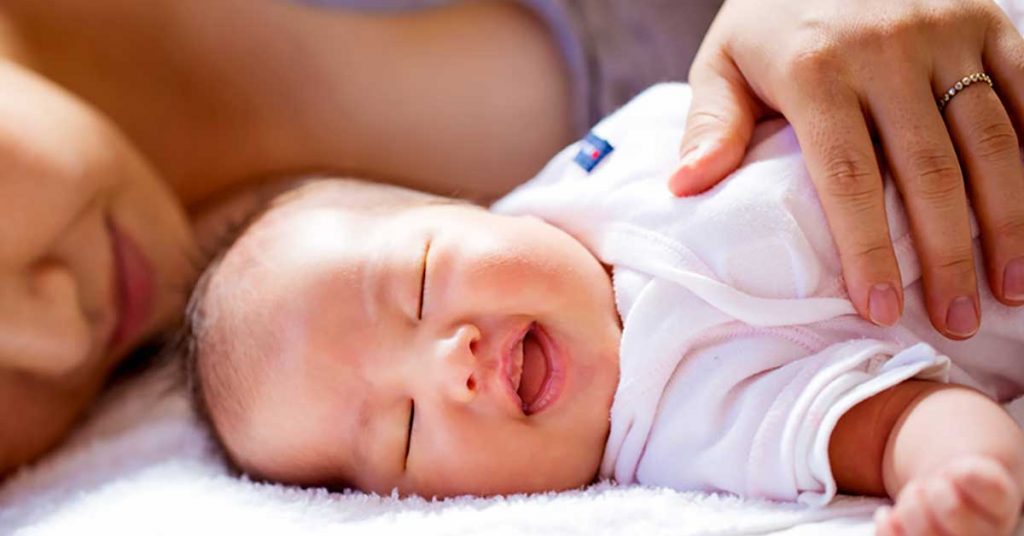Babies constantly drift through sleep cycles throughout the night, just the way we drift between a deep sleep and being fully awake. There are moments when we feel like we just slept an hour ago and hey, here’s the next day! This happens with those little ones too, in fact much more quickly than it happens with adults. I can understand the happiness one feels from within when they observe their little one smiling and I can promise you this is one of the most special sights.
Well, there are different stages of a sleep cycle that vary from person to person. So, to find out the reason as to why do babies laugh while they are sleeping, it is important for us to understand these stages. We have discussed these stages below:
Read More: Tips on Handling Sleep Problems In infants
All You Need to Know About Baby Laughing in Sleep
Different Stages of a Baby’s Sleep
Stage – 1: Non-REM Sleep
This is what we can also call as light or shallow sleep. As this is stage-1, so it is the first step between being awake and sleep. During this stage, our bodies become more relaxed and breathing becomes regular. However, even the slightest of sound or movement can make us awake.
Read More: 7 Foods that can Help you and your new Baby to Sleep
Stage – 2: Non-REM Sleep
Basically, this is the first stage of light sleep. The heart rate slows down and the body temperature begins to drop. If we talk about babies, we can notice the twitching and grunts during this stage.
Stage – 3: Non-REM Sleep
Considering stage 3 and 4, there is hardly any difference between the two, until you try to measure it on a polygraph. During this stage, our bodies are completely relaxed and if a sudden sound or movement makes you awake, you are likely to react to it a little slowly and apparently drift back to sleep again.
Read More: How Much Sleep does Your Newborn Need?
REM Sleep
This stage is vital not only for the babies but also for the adults. During this stage, one can be easily awoken and there is an increased flow of blood to the brain that helps the baby’s brain to grow. Also, the secretion of growth hormones takes place during this stage, which is why it can be said that your baby may sleep more when he/she is going through this phase. However, it takes a while to reach to this stage.
It is during this stage that dreams occur in adults. Now one can also argue that as babies reach this stage as well, it can be said that they have dreams too.
As there is increased heart rate and breathing during this stage, thus your baby is likely to show those involuntary body movements that may involve their face, fingers and legs twitching a lot or movement of their eyes. Thus, we often get to see those little smiles and laughs during REM sleep.
Read More: 5 Ways to Improve Sleep Quality After the Birth of a Newborn
Classification of Baby Smiles
Many people believe that the reason for babies smiling and laughing during their sleep can be something they see in their dreams, which can be also be called as the developmental stage. Depending on the developmental stage, we can classify these little smiles into:
Reflexive smile
Babies who are 0 to 1 month old are not able to consciously smile in reaction to something they see. Although you might see the twitches (which we think of as smile), but there is not really any emotional connection to that. It is just their body practicing another reflex in order to prepare for something that is actually real. Also, one may say that these are the smiles that you generally see during REM sleep that make you think that the baby might be having a dream.
Gas smile
As the name depicts, these are basically the involuntary facial expressions that can depict their relief from an unwanted tummy gas. These may as well occur during the sleep that can make it seem like your baby is smiling in a dream.
Reactive smile
When your baby is 2 months old, he/she begins reacting to things he/she likes. During this stage, your baby begins to understand a bit and can react to the surroundings. However, there is still a difference between a reactive smile and a social smile.
Social smile
Now that your baby is 3-4 months of age, it is easy for us determine their excitement for things they like. Here, one can say that when she is smiling at you, she has started to form that connection with you and her environment. In fact, even the baby knows why she is smiling and she may even try to get your attention by smiling at times.
Medical causes
Apart from this, there are also certain types of seizures that may occur in infants. Although it is very are but this can lead to several episodes of uncontrolled giggling. These may last for around 10 to 20 seconds and can begin when the baby is 10 months old. But, in case you notice this happening multiple times, it is important that you consult a paediatrician. The occurrence of these laughing episodes can affect your baby’s sleep negatively, which can further have an impact on your baby’s health as well.
Conclusion
As these little ones cannot talk to us, it’s almost next to impossible to figure out the exact reason of their smiles during a sleep. As far as we talk about science, there have been a lot of research on this aspect but we still do have a clear reason. Although this sight may be a little unexpected but there is nothing to worry about and it is very common among the little one and thus, absolutely normal.
References
https://www.independent.co.uk/news/science/revealed-the-serious-science-behind-a-babys-laugh-8225400.html – INDEPENDENT
https://www.parents.com/baby/development/laughing/how-baby-smiles-develop/ – Parents
